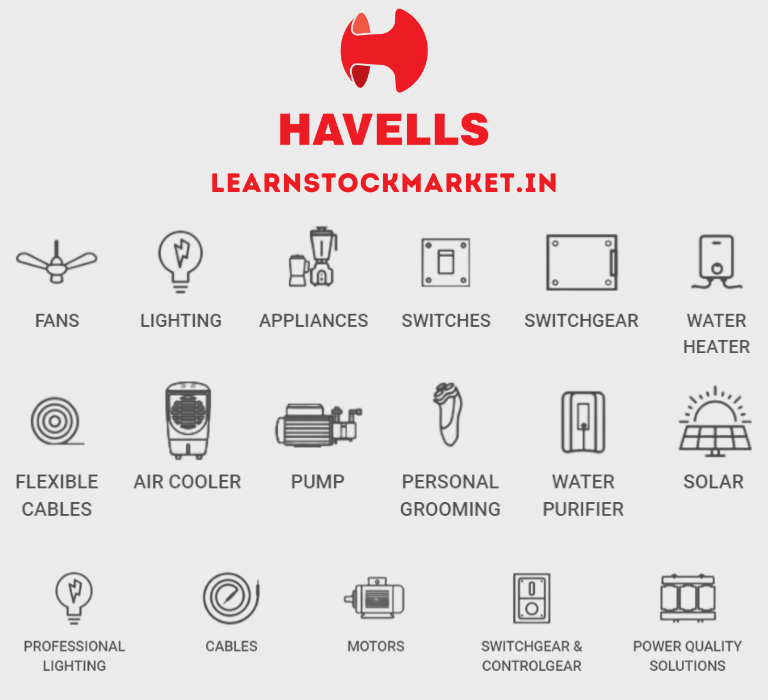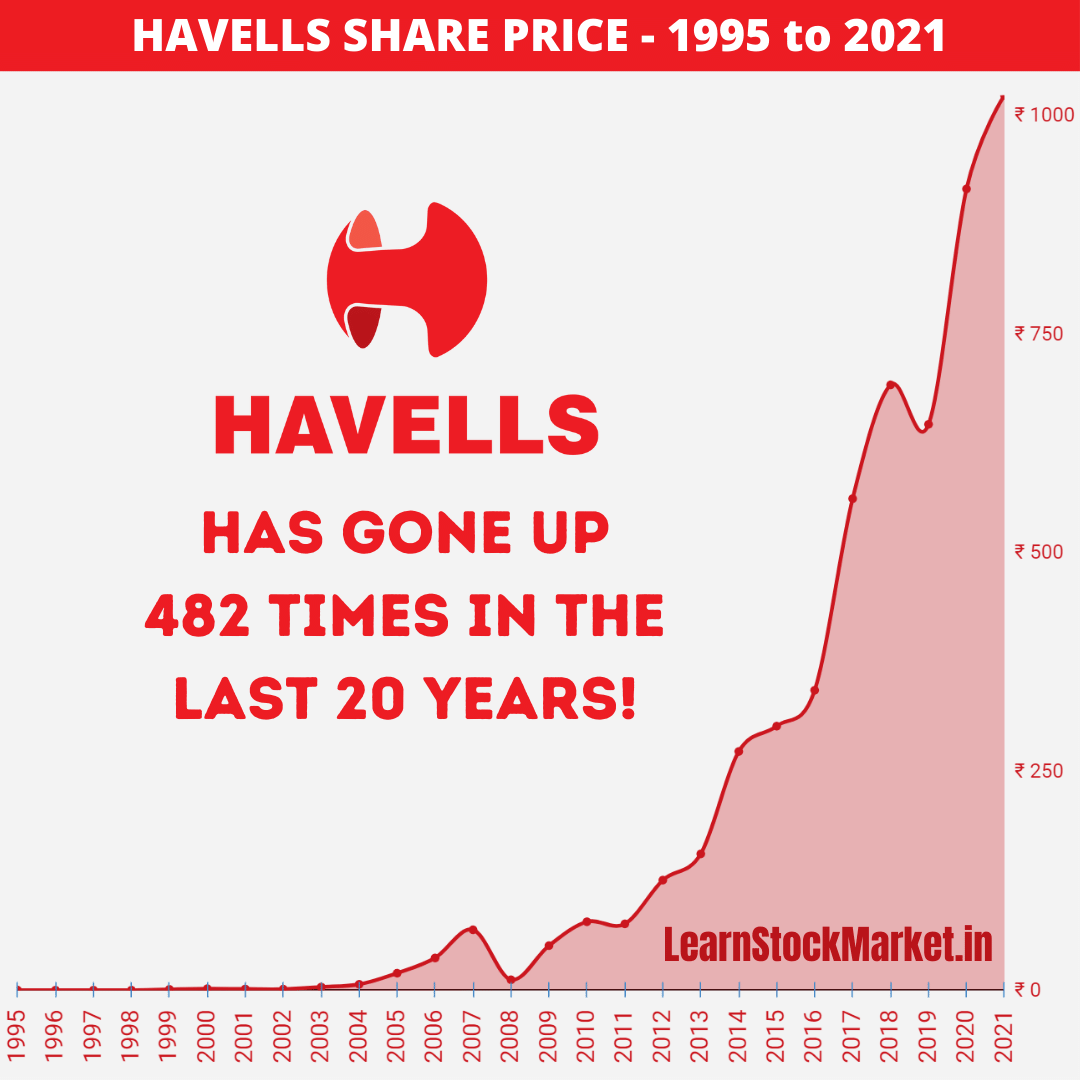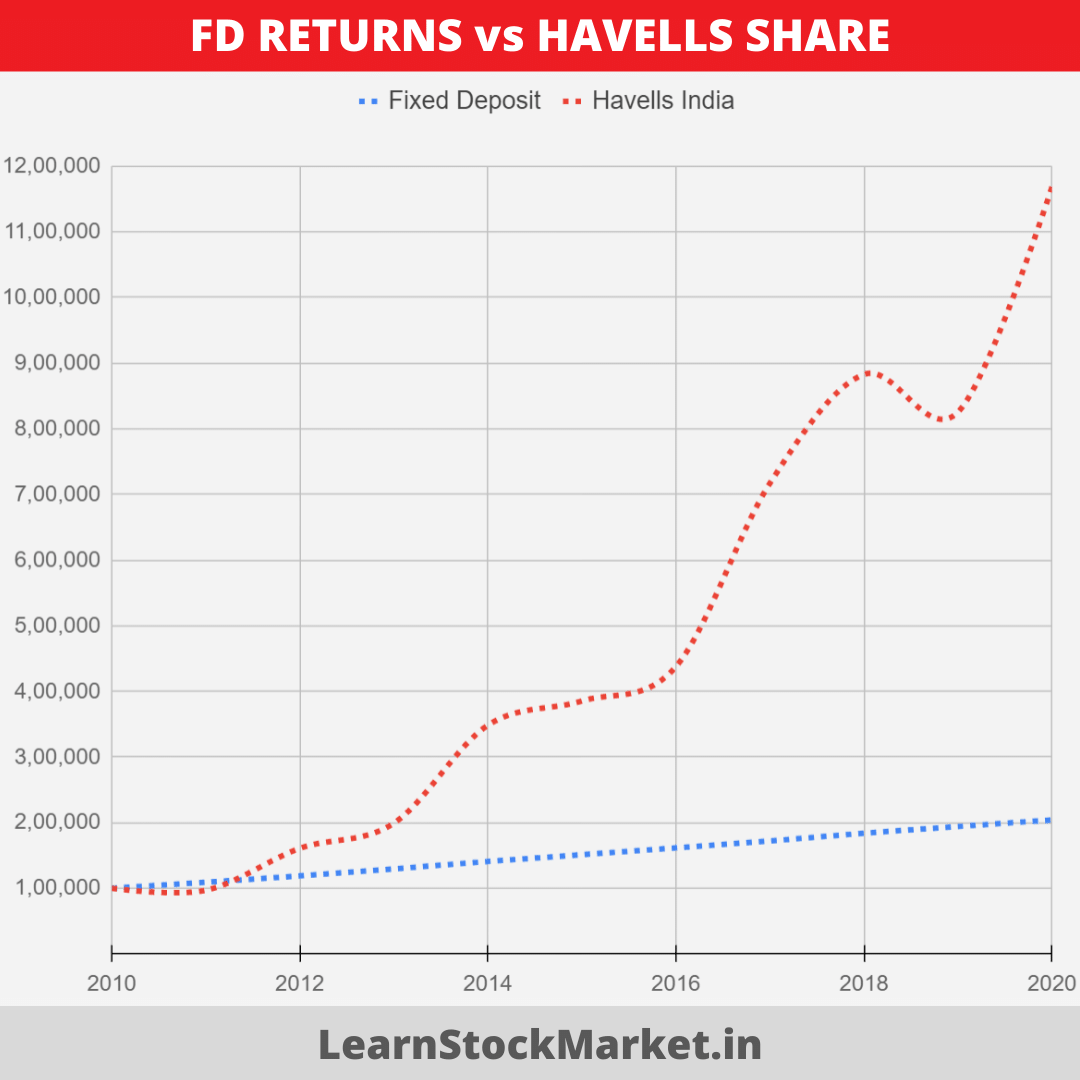Havells is a well-known brand in India. The company has been in business for over 6 decades, but it is the last 2 decades that has seen Havells establish itself as a top brand.
The company specializes in consumer as well as industrial products.

Customers love their products. Go to Amazon.in, search for ‘Havells’ and you will see hundreds of different products with excellent reviews.
When a company produces products which customers love – and if that company is listed in the stock market – a quick look at the history of the share price will tell you, it has rewarded its long-term investors.
Havells has given excellent returns to shareholders in the few couple of the decades and the future looks bright too.
Let us take a look at the history of the share price.
Havells Share Price
| Havells | Share Price | Rise / Fall |
| 1995 Share Price | ₹ 0.27 | |
| 1996 Share Price | ₹ 0.19 | -29.63% |
| 1997 Share Price | ₹ 0.26 | 36.84% |
| 1998 Share Price | ₹ 0.23 | -11.54% |
| 1999 Share Price | ₹ 1.15 | 400.00% |
| 2000 Share Price | ₹ 1.9 | 65.22% |
| 2001 Share Price | ₹ 1.55 | -18.42% |
| 2002 Share Price | ₹ 1.4 | -9.68% |
| 2003 Share Price | ₹ 3.8 | 171.43% |
| 2004 Share Price | ₹ 6.9 | 81.58% |
| 2005 Share Price | ₹ 19.6 | 184.06% |
| 2006 Share Price | ₹ 37 | 88.78% |
| 2007 Share Price | ₹ 69.2 | 87.03% |
| 2008 Share Price | ₹ 12.1 | -82.51% |
| 2009 Share Price | ₹ 51.1 | 322.31% |
| 2010 Share Price | ₹ 78.4 | 53.42% |
| 2011 Share Price | ₹ 76 | -3.06% |
| 2012 Share Price | ₹ 126 | 65.79% |
| 2013 Share Price | ₹ 156 | 23.81% |
| 2014 Share Price | ₹ 273 | 75.00% |
| 2015 Share Price | ₹ 302 | 10.62% |
| 2016 Share Price | ₹ 343 | 13.58% |
| 2017 Share Price | ₹ 562 | 63.85% |
| 2018 Share Price | ₹ 692 | 23.13% |
| 2019 Share Price | ₹ 647 | -6.50% |
| 2020 Share Price | ₹ 916 | 41.58% |
| 2021 Share Price | ₹ 1023 | 11.68% |
The Share Price of Havells has had its share of ups and downs, but when the fall has been big – the rise has been bigger.
The toughest period for an investor in Havells was the 2008 stock market crash. The stock price crashed from nearly 70 rupees at the beginning of the year to around 12 rupees at the end of 2008.
Those who held their shares during that period, have been rewarded in the next decade and a half – as the share price of Havells from lows of ₹ 10 at the beginning of 2009, has crossed ₹ 1000 in 2021.
That’s 100x returns in 12 odd years.
It’s impossible to buy at lows, or sell at highs – but irrespective of when you bought shares of Havells in the last 10 years, the returns have been better than fixed deposits or most mutual funds.
The advantage of directly investing in such companies and holding them for long periods of time is – you do not have to pay taxes or fees to mutual fund companies.
If you deposit money in a fixed deposit, you will end up paying tax on interest earned every year. If you buy mutual funds, you pay 1-2% every year.
Directly buying and holding stocks carry one big advantage – you only pay 10% tax on gains when you sell. The gains can also be set-off against long term capital loss, which can be carried forward for a period of 8 years.
Back to the topic, the chart of Havells is unbelievably good.

There was one major dip in 2008 and then another correction during the 2020 market crash. But apart that, it has been a fairly smooth ride as Havells has become one of the most-trusted brands in the country.
Note: All Havells India Share Prices mentioned above have been adjusted for share split and share bonus. The shares have been split twice; once in 2003 and then again in 2014. 1:1 Bonus shares have been issued 3 times; in 2005, 2006 and 2010. In short, if you had about 1 share of Havells back in 2002 – after all the split and bonuses – you would have 200 shares of the company today!
Havells Share Returns
How much returns has Havells given in the last 2 years? What about 3, 5, 10, 20 years?
Check out the table below:
| CAGR | Absolute | |
| 1 year | 41.58% | 1.42 |
| 2 years | 15.05% | 1.32 |
| 3 years | 17.68% | 1.63 |
| 4 years | 27.84% | 2.67 |
| 5 years | 24.85% | 3.03 |
| 10 years | 27.87% | 11.68 |
| 15 years | 29.21% | 46.73 |
| 20 years | 36.19% | 482.11 |
| 25 years | 38.42% | 3,392.59 |
You could not have gone wrong by investing in Havells in the last 2 decades. The stock has consistently outperformed the market – with compounded annual returns above 20%.
If you had invested in Havells 20 years ago, each rupee invested would be valued 482 times.
The 5-year and 10-year returns are excellent too – without including dividend.
The company has a good dividend track record, it has consistently declared dividends in the last 10 years.
1 Lakh invested in Havells
If you had invested 1 lakh in ‘Havells India’, how much returns has it given over different time periods?
The table below has the figures:
| ₹ 1 Lakh Invested | |
| 1 year | ₹ 1.42 lakhs |
| 2 years | ₹ 1.32 lakhs |
| 3 years | ₹ 1.63 lakhs |
| 4 years | ₹ 2.67 lakhs |
| 5 years | ₹ 3.03 lakhs |
| 10 years | ₹ 11.7 lakhs |
| 15 years | ₹ 46.7 lakhs |
| 20 years | ₹ 4.82 crore |
| 25 years | ₹ 33.93 crore |
An investment of 1 lakh, 5 years ago, would be valued at ₹ 3.03 lakhs today. The same investment made 15 years ago, would be worth nearly 47 lakhs today.
If you were one of the earliest investors in the company and bought shares of Havells, 25 years ago, 1 lakh would be worth nearly 34 crores today.
These numbers sound extraordinary, but do remember that investing is tough. Even those who invested 25 years ago, would have seen their investments multiply several times in the next 13 years.
Out of nowhere, the 2008 financial crisis happened. All the wealth accumulated over decades in Havells was wiped out within months. During such times, it is difficult to have faith in equity investments and stock markets in general.
The 2008 crisis wasn’t India’s fault. Even during the crisis, when foreign banks were struggling, HDFC Bank was posting excellent results. Yet, the pain in the market was tremendous. Those who sold at the lows in 2008, were either out of the market forever or would have found it extremely difficult to get back to investing in the stock market.
Moving on…
Havells vs FD Returns
What if you opened a fixed deposit of 1 lakh in a bank and made another investment of 1 lakh in Havells Shares. Let’s assume both investments were made in the year 2010 (i.e. 10 years ago).
The results are below.
| Fixed Deposit | Havells | |
| 2010 | 1,00,000 | 1,00,000 |
| 2011 | 1,09,130 | 96,939 |
| 2012 | 1,18,821 | 1,60,714 |
| 2013 | 1,29,515 | 1,98,980 |
| 2014 | 1,40,692 | 3,48,214 |
| 2015 | 1,51,075 | 3,85,204 |
| 2016 | 1,61,469 | 4,37,500 |
| 2017 | 1,72,093 | 7,16,837 |
| 2018 | 1,83,710 | 8,82,653 |
| 2019 | 1,93,997 | 8,25,255 |
| 2020 | 2,04,027 | 11,68,367 |
| Returns | 7.39% | 27.87% |

Note: FD interest rates have been adjusted each year, as per data taken from Reserve Bank of India. The average FD rate over last 10 years has been around 7.4%. It’s lower at the time of writing this article, but it was higher in 2010.
Some points, including the psychological aspect of investing:
- We have analyzed the stock price history of several well-known companies over the last few months.
- One thing is clear – over a long period of time, most companies have ended up giving better returns than a fixed deposit.
- Even though the last 10 years haven’t exactly seen the economy fire on all cylinders, equity or stock market investment has beaten fixed deposits. It’s been choppy, it has been difficult – yet most of the top companies have given excellent returns to investors.
- The Havells story is no different. Suppose you invested 1 lakh in Havells in 2010, the first year would be loss-making. This is something which often happens in the stock market. It is at this time that investors lose patience and sell.
- If you held on, Havells has given excellent returns.
- At the end of the 10 year period, while the 1 lakh in fixed deposit would have just about managed to touch 2 lakhs – the investment in Havells would have crossed 11.5 lakhs. Returns like these can change your financial life!
- However – 1 lakh became 12 lakhs. Easy, isn’t it? Not at all.
- A lot of people fear stock market crashes, but one of the biggest problems investors face is the inability to hold a stock for a long period of time.
- Try to imagine in your mind, you actually invested 1 lakh in Havells back in 2010. By 2013, the value of your investment had doubled. “100% returns! Should I sell and buy some other share?”
- By 2015, it had gone up 300%. During this time, you would constantly think about selling. With the stock price going higher, the fear of a fall increases.
- You will start thinking – “An ₹ 80 share has gone up to ₹ 300 rupees. How much more can it go? When should I sell?”
- “Are the valuations too high? The price-to-earning (PE) is definitely higher than normal”
- “What if there is a crash like 2008 and I lose all my gains?”
- “The price will definitely correct. I will book some profit now and when the share price falls, I will buy again” A big mistake, because good quality companies rarely give a chance to buy again lower.
- Even if it does go down, you will wait for the price to fall a little bit more.
- These are some of thoughts and emotions almost every investor goes through. This makes long-term investing extremely difficult.
- And it is boring too. You have to buy and do absolutely nothing for several years.
- In fact, it is easy to hold a stock in loss for a long period of time. But holding a fast-rising stock needs market experience. You have to go through these situations, learn, have regrets and do better in the future.
- That’s the reason why the chart above looks great, it seems easy to replicate. But when you buy the stock and hold it in your portfolio – the game is different altogether.
The psychological aspect is what we give a lot of importance to on this website. You can learn fundamental analysis, technical analysis or any other kind of analysis – but if you do not have the right mindset and patience – you cannot become a successful investors.
Remember, the goal is not to make quick money to spend. The goal is not even to get rich. The goal is to become wealthy, never to worry about money.
Among all available investment options, we strongly believe, only the stock market can make you wealthy in a relatively shorter period of time.
We hope you found this article helpful. If you have any questions or suggestions, please post them in the comments section below.
Disclaimer: We do not recommend stocks on this website. Stocks are analyzed for educations purposes only. Investing in the stock market carries risk. Kindly contact your financial advisor before making any buy or sell decisions.

Can you share a similar share price analysis of Dabur, HUl, Marico,Aurobindo Pharma
I think it will be great use for the web visitors and more and more people would like to know about the same.